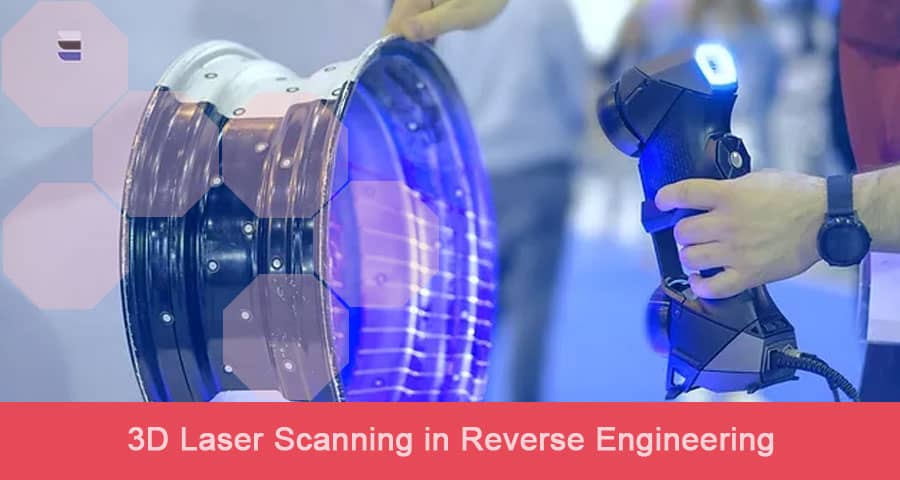3D Laser Scanning in Reverse Engineering

In today's world, technology has revolutionized the engineering industry. One such advancement is 3D laser scanning, which has transformed the way engineers work and design. In reverse engineering, 3D laser scanning has become an essential tool, as it helps engineers to understand the complexities of a product's design and functionality.
Introduction
Reverse engineering has become a crucial aspect of the engineering industry, and it involves the process of disassembling a product to understand how it works and how it can be improved. One of the most significant challenges in reverse engineering is creating accurate and detailed 3D models of the product, which is where 3D laser scanning comes in. 3D laser scanning has become an essential tool in reverse engineering, as it helps engineers to capture the complex details of a product's design and functionality accurately.
What is 3D Laser Scanning?
3D laser scanning is a non-contact measurement technique that uses a laser beam to capture the physical dimensions of an object. The laser scanner emits a laser beam, which bounces off the surface of the object and returns to the scanner. The scanner then records the time it takes for the laser beam to travel from the scanner to the object and back, and the distance between the scanner and the object can be calculated based on the speed of light. This process is repeated multiple times from different angles, creating a 3D point cloud, which is then used to create a 3D model of the object.
How does 3D Laser Scanning work?
3D laser scanning involves several steps:
- Planning: The engineer plans the scanning process, identifying the areas to be scanned and the level of detail required.
- Scanning: The scanner emits a laser beam, which bounces off the surface of the object and returns to the scanner. This process is repeated multiple times from different angles, creating a 3D point cloud.
- Registration: The point clouds are combined and aligned to create a complete 3D model.
- Post-Processing: The 3D model is cleaned up, and additional details are added to create a final 3D model that is ready for use.
Advancements in 3D Laser Scanning
Over the years, 3D laser scanning technology has undergone significant advancements, making it more accurate, efficient, and accessible. Some of the major advancements include:
High-Resolution Scanning
With advancements in laser technology, 3D laser scanners can now capture details as small as a few microns, making it possible to create highly accurate and detailed 3D models.
Portable Scanners
Portable 3D laser scanners have become more compact, lightweight, and affordable, making them accessible to a broader range of industries and applications.
3D Printing
The ability to 3D print 3D models has revolutionized the engineering industry, as it allows engineers to create physical prototypes quickly and efficiently. 3D laser scanning technology has made this process even more accessible, as it enables engineers to create highly accurate and detailed 3D models that can be directly 3D printed.
Applications of 3D Laser Scanning in Reverse Engineering
3D laser scanning has become an essential tool in reverse engineering, and it is used in a wide range of applications, including:
Product Design and Development
3D laser scanning is used to create accurate and detailed 3D models of existing products, which can then be used to design new products or improve existing ones. This process enables engineers to understand the product's design and functionality and identify areas for improvement.
Manufacturing and Quality Control
3D laser scanning is used in the manufacturing process to ensure that products are produced to the required specifications. It is also used in quality control to check for defects and ensure that the products meet the required standards.
Restoration and Repair
3D laser scanning is used in the restoration and repair of historical artifacts, sculptures, and buildings. The 3D models created through laser scanning can be used to create accurate replicas or to identify the areas that need to be repaired.
Aerospace and Automotive Industry
3D laser scanning is used in the aerospace and automotive industry to create accurate 3D models of existing parts, which can then be used to design and manufacture new parts. This process enables engineers to improve the performance and efficiency of these parts.
Challenges in 3D Laser Scanning
Despite its many benefits, 3D laser scanning also presents several challenges, including:
Data Management
3D laser scanning generates vast amounts of data, which can be challenging to manage and process. Engineers need to have the necessary software and hardware to store and manage this data.
Data Processing
Processing the 3D data generated through laser scanning can be time-consuming and require specialized software and hardware. This process can also be complex and requires skilled engineers with expertise in 3D modeling and design.
Cost
3D laser scanning technology can be expensive, and the cost of the scanners and the necessary software and hardware can be a significant investment for many companies.
Conclusion
3D laser scanning has become an essential tool in reverse engineering, and its advancements have transformed the way engineers work and design. With its applications in product design and development, manufacturing, restoration and repair, and the aerospace and automotive industry, 3D laser scanning has become an indispensable tool for many engineers. However, despite its many benefits, 3D laser scanning also presents several challenges, including data management, data processing, and cost.
